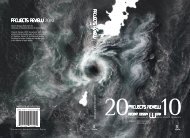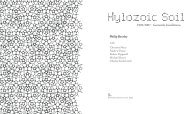The Inner Studio - Riverside Architectural Press
The Inner Studio - Riverside Architectural Press
The Inner Studio - Riverside Architectural Press
Create successful ePaper yourself
Turn your PDF publications into a flip-book with our unique Google optimized e-Paper software.
PART THREE | INNER RESOURCES<br />
Yang energy is masculine and is described as light, dry, directed,<br />
focused, logical, and action-oriented. Yin energy is feminine and<br />
described as dark, moist, diffuse, vague, intuitive, and receptive. A<br />
simple example of the way these two energies are combined may be<br />
found in the act of walking. First we need to learn to stand and get<br />
grounded, which is feminine energy. This is followed by the energy<br />
used to step forward, which is masculine. In the creative process, we<br />
experience both of these energies. A creative cycle of work involves<br />
receptivity or containment followed by a pulsation of something new<br />
that inspires us and moves us forward, which is in turn contained<br />
again before another wave of new images or ideas comes forth.<br />
What interests me is the question of how these unconscious traits<br />
find their way into the built world and how designers can learn to<br />
work more consciously to bring these covert characteristics into their<br />
work. Contra-sexual traits represent ways of experiencing the world<br />
that are often excluded from our understanding of a design problem.<br />
Yet what makes a design great is the way it manages to touch us<br />
precisely because it embraces and transcends and makes conscious<br />
what had once been thought of as irreconcilable opposites.<br />
Cities that have lost their feminine qualities are full of places<br />
where people no longer want to live. <strong>The</strong>se places have often been<br />
spoiled by large-scale infrastructure or ruined by political willfulness<br />
that leaves us with no choice but to resort to extra policing for<br />
life to feel possible. Public places that graciously draw us out of our<br />
separateness offer us the setting we need to gather in peace and<br />
watch life unfold. <strong>The</strong>se kinds of places, like Pailey Park in New<br />
York, are nearly impossible to quantify to a patriarchal civic<br />
bureaucracy, yet they offer a refuge that fundamentally understands<br />
our human longing to connect with others and ourselves. Airports,<br />
when they are overly concerned with complex issues of organizational<br />
movement, ignore the deep-seated anxiety that accompanies<br />
the modern experience of travel. When offices become too<br />
concerned with performance, mysteriously, performance declines.<br />
How did the culture of design evolve to the point that our schools<br />
often resemble factories or prisons?<br />
When the symbolic masculine and feminine elements of design<br />
work together, their own properties are expanded. Bridges are<br />
83





